 Back to Articles Index.
Back to Articles Index.
A Practical Examination of Wefts used in Medieval Brocaded Tabletweaving
This was my entry in the Laurel category of the Drachenwald Arts & Sceinc competition in April 2004. I have made some minor additions since then which are marked like this.
 Back to Articles Index.
Back to Articles Index.
Brocading is the technique of using one or more additional wefts to create patterns on a band. The brocade threads are not necessary for the structural integrity of the fabric; they lie on the surface and are held down by being woven into the material at certain points (the so-called tie-down points). The vast majority of tabletwoven bands surviving from the middle ages were brocaded with gold or silver thread, not necessarily because brocading was so much more common than non-brocaded tabletweaving - an unlikely proposition, given the cost of the thread - but rather because the metal survived (sometimes the chemicals released by corrosion of the metal even perserved the underlying fabric), while the threads of non-brocaded bands simply disintegrated over time.
The length of a brocaded pattern is usually measured in picks per centimetre, i.e. the number of times the brocade wefts crosses from one side of a band to the other in a given length of the band. This depends on three things: the thickness of the ground warp, the thickness of the brocade weft, and the thickness of the ground weft. These three factors determine how good the coverage of the brocade is, i.e. how much of the ground warp is hidden by the brocade. If the brocade thread is too thin, the coverage suffers, although this can be alleviated by using two or three brocade wefts side by side.
I had three primary goals with this project:
| 1. To examine as wide a range of medieval wefts as possible | ||||||||||||||
For purposes of this project I divided the types of period brocade weft into
three groups:
Modern equivalents of all these wefts are available, and I included as many variations as I could find. |
||||||||||||||
| 2. To gain understanding of how to work with the different materials | ||||||||||||||
| To me this was one of the central issues of the project. Handling the materials and working with them is integral to understanding their behaviour; without this knowledge designing future pieces is a much more chancy effort. I have detailed my observations in the following section. | ||||||||||||||
| 3. To compare the resulting samples to period pieces | ||||||||||||||
To weave as authentic a reproduction as possible it is necessary not only to
use period-type materials but also to compare their properties and the resulting
band. This requires technical data which is not always provided by books dealing
with brocaded bands, but enough information is available for some essential comparisons.
|
||||||||||||||
Observations on Weaving (12)
Band 1: Synthetic 'Metallic' Threads
Synthetic threads are much more easily available than real metallic wefts; they
are also comparatively cheap and are used by many tabletweavers including published
authors like Nancy Spies
(13).
These threads consist of a core wrapped with a metal-like strip of synthetic
material, generally mylar. Although the material is modern, the structure of the
thread is the same as for period metallic wefts.
 |
Section 1 (Pall): This is a very fine thread, so fine in fact that it would have to be used either double or triple, or be brocaded over finer silk. Many period bands show 30 or more picks/cm, and a weft like this (or even thinner) would have been required to achieve this. There are multiple extant medieval bands where the weft was doubled or even tripled, as for example in the St Truiden textiles (14). |
 |
Section 2 (Fess): This thread had a very slick, plastic feel to it while I was working with it, but the final result is in my opinion the best-looking of the synthetic materials. It has good coverage and is not as glitzy as the next two threads. |
 
|
Section 3 (Chevron) and Section 4 (Bend): These two threads are the same type, Kreinik Japan #7, which many tabletweavers use as a substitute for metallic wefts. It is much more expensive than the other synthetic wefts I used, but by comparison to the real metallic wefts has a rather artificial look. |
Band 2: Real Metallic Threads
I wove this band using real metallic wefts, consisting of a thin strip of metal
wound around a central core. Aside from lesser differences such as the exact
composition of the metal, these threads are precisely what medieval tabletweavers
would have used.
 
|
Section 1 (Quarterly) and Section 2 (Cross): These two threads came to me from India via my Laurel and Pennsic, and I have no idea as to their provenance, nor have I been able to find a source for them on the web. They are very nice to work with; the weft slides through the warp quite easily. The silver thread is a touch too fine for this grade of silk, and should be used double for better coverage. |
  |
Section 3 (Chief Embattled) and Section 4 (Pale): This is a metallic weft with a silk core, and although it is somewhat thicker than most period metallic threads there are a number of examples of threads of similar weight (e.g. the trim on the 12th century chasuble of Bishop Bernard of Hildesheim (15)). I do not know what the actual metal content is, and though the gold thread is perhaps not as bright as true gold would be, to me it is the best metallic thread I have located so far. The only minor downside I found is that because the surface is not entirely smooth, there is some resistance when the weft is pulled through the shed and slightly more force is necessary than with other wefts. |
Band 3: Solid Metal Wefts

|
Section 1 (Saltire): I used gilded silver wire with a diameter of 0.3mm for this, similar to the wires used in the brocades from the 9th century Birka graves (16)). Working with wire is somewhat trickier that working with thread because once the wire has been bent at the turning point, if a mistake has been made it is quite hard to undo and straighten out the kinks in the wire. It is also necessary to have a fairly wide plain border between the end of the brocaded area and the edge of the band to give the wire room to turn underneath the band; thread-type wefts require much less space to turn. |

|
Section 2 (Pile): I used the same wire as for the previous section, but here I flattened the wire by careful hammering after the weaving was completed. The hammering causes the wire to flare out and cover the underlying warp much better, but it has to be done carefully enough so as not to damage the silk. It is also noticeable that the hammering causes the wire to lose the bright polish of the first section. |

|
Section 3 (Label):
I could not find silver wire (silver-plated copper, to be precise) in less
than 0.4mm thickness, which (from prior experimentation) is much too thick
to weave with. For this section I flattened the wire by the simple expedient
of running it several times through a hand-cranked pasta machine, which is
essentially a very basic rolling mill. The resulting strip was still a bit too thick to work with, but hammering the wire caused distortions and marred the surface so I decided to work with what I had. This section was probably the trickiest one to do. The silver strip was thick enough that turning it at the right point took a lot of care, and even so it was not possible to make it lie flat all the time, and in one place there is a large section of wire protruding from the back of the band. In a real band I would cut off that section and flatten the ends, but I left the protrusion as an example of what can go wrong. I managed to fix some problems by the careful application of needlenose pliers and minimal force, but there are limits to this, and in one instance I snapped two of the silk threads by applying too much force. The overall effect, however, is worth it. |

|
Section 4 (Mascle): For this section I took 0.3mm gilded wire and flattened it by the use of a plain marble rolling pin. The resulting strip was much thinner than the silver strip and consequently easier to handle. I still had the same difficulties as with the silver strip, but to a lesser extent. I imagine that pure gold, rather than gilt silver, will be even easier to work with, but so far I have not acquired any real gold wire. When looking at the back of the band, one noticeable feature in both this and the previous section is that where the metal strip turns it lies edge-on to the band. I found it virtually impossible to prevent this; with a thinner gold foil it should be possible to fold the strip flat at the turning points (as the remains from the Taplow burial show), but my strips were too thick to achieve this properly. This raises the danger that too much pressure on the band might cause the silk to eventually begin fraying against the edge of the metal strip. |
Band 4: Non-Metallic Wefts
There are two major advantages in using non-metallic wefts: using dyed silk or
wool makes far more colours available to the weaver, and the flexibility of the
band remains virtually unchanged. Any band brocaded with a metallic weft is very
stiff across its width, and this is even more so when a solid metal weft is used.

|
Section 1 (Per Fess): This is merino wool of approximately the same thickness as the underlying silk. Because the wool is slightly fuzzy it can spread out a bit and thus the coverage is quite good. The only risk I found with the wool is that it is not as strong as the other wefts, therefore a bit more care must be taken not to pull the brocade weft in too tight and break it. |

|
Section 2 (Per Pale): In this section I used the same type of silk as the ground weave. Brocading with silk involves the least difficulties of all the wefts I tried: the thread is tightly spun and there are no problems in pulling the weft through, and since it is more flexible than metallic thread it requires hardly any turning space at the edge of the band. |

|
Section 3 (Two Pallets): Many period bands brocaded in silk use multiple colours, so here I duplicated that effect. It was interesting to realise that using two silk brocade threads instead of one makes virtually no noticeable difference to the flexibility or the thickness of the band. |

|
Section 4 (Bendy):
This section shows a combination of metallic and silk weft, as was done in
many medieval brocaded bands. A noteworthy point in this example is that
there is no separate tie-down between the interchanges from metallic to silk
weft. There are a number of medieval bands with patterns of this type, for
example some of the St. Truiden brocades
(17)). The effect of this pattern is that at the point where the metallic thread disappears into the band, the silk rises to the surface, and for lack of any other space the two wefts must necessarily lie next to each other. This causes small gaps to appear between the brocade wefts where the green ground warp shows through. This was not intentional on my part and something I only discovered while working on this pattern. If the contrast between the ground warp and the brocade weft is low (e.g. as in the blue bends) the effect is not very noticeable, but with a high contrast weft it could be quite disruptive. |
Band 5: Brocaded Wool
Although most documented brocaded bands have a silk base, there are a significant
number of bands brocaded over wool. Since the ground warp influences the appearance
of the brocade I wove this band to see how it compared to a silk base, using wool
which is similar in thickness to the silk.
The main difference in brocading over wool vs silk is that wool is less rugged and
must be treated with more care than silk. It is also more elastic than silk, and
for both these reasons wool cannot be beaten down as tightly as silk, thus giving
less coverage in the brocade. It is noticeable that each of the sections on the
wool band is wider than the pattern with a corresponding weft on silk.

|
Section 1 (Chequy): The brocade weft here is the same type of wool as the ground warp. This was the last section I wove (yes, my order of weaving is backwards) and the warp was fraying so badly that I did not want to risk unweaving the mistakes I made. Wool tends to be quite clingy and stick to itself, but I experienced no problems in pulling the weft through the shed. |

|
Section 2 (Gyronny): Working with linen weft was surprisingly pleasant; the thread is very firm and gives a solid surface which results in good coverage on the wool. |

|
Section 3 (Barry): I found one 13th century example of wool brocaded with silk (18)), presumably to give the effect of a silk surface while saving money on the ground warp. I find that the result has a less striking effect than the linen brocade. |

|
Section 1 (Chevronelly): Most examples of brocaded wool which I found were done with a metallic weft. I had half expected to have some minor difficulties such as the weft snagging on the wool fibres, but in fact there was no problem weaving this section. However, I find that the coverage is much less impressive than on silk; laying the weft double might improve the appearance. |
My personal favourites are the flat metal strips, both silver and gold, and the van Sciver metallic threads, especially when combined with additional multi-coloured silk wefts. It does take a lot of extra work, but the effort is undeniably worth it.
As a whole the project provided me with a great deal of insight into brocaded tabletweaving and made many things much clearer in a very graphical fashion - for example why someone would go to all the effort of brocading with thin strips of metal, or spend twice or thrice the time in working with several different wefts in one piece. The theory is easy to understand, but it requires the visual impact of an actual piece to really get a feeling for what the original medieval bands would have looked like.
| Band 1: Synthetic 'Metallic' Threads | ||
| Section 1 (Pall) | No-name brand synthetic silver thread | |
| Section 2 (Fess) | No-name brand synthetic gold thread | |
| Section 3 (Chevron) | Kreinik Japan #7 Silver thread | |
| Section 4 (Bend) | Kreinik Japan #7 Gold thread | |
| Band 2: Real Metallic Threads | ||
| Section 1 (Quarterly) | Indian Silver thread | |
| Section 2 (Cross) | Indian Gold thread | |
| Section 3 (Chief Embattled) | van Sciver Silver thread | |
| Section 4 (Pale) | van Sciver Gold thread | |
| Band 3: Solid Metal Wefts | ||
| Section 1 (Saltire) | Gilded silver wire, 0.3 mm diameter | |
| Section 2 (Pile) | Gilded silver wire, 0.3 mm diameter, flattened after weaving | |
| Section 3 (Label) | Silver strip, 0.57 mm wide, 0.21 mm thick | |
| Section 4 (Mascle) | Gilded silver strip, 0.52 mm wide, 0.14 mm thick | |
| Band 4: Non-Metallic Wefts | ||
| Section 1 (Per Fess) | 2/48 Merino wool | |
| Section 2 (Per Pale) | 60/2 Bombyx silk | |
| Section 3 (Two Pallets) | Dual 60/2 bombyx silk | |
| Section 4 (Bendy) | Dual silk and van Sciver gold thread | |
| Band 5: Brocaded Wool | ||
| Section 1 (Chequy) | 2/48 Merino wool | |
| Section 2 (Gyronny) | #16 Linen | |
| Section 3 (Barry) | 60/2 Bombyx silk | |
| Section 4 (Chevronelly) | van Sciver Gold thread | |
Appendix B: Brocaded Samples - Weft Data
All the brocaded samples have the same pattern width of 50 picks.
| Weft | Woven Width | Picks/cm | |
| Synthetic | |||
| No-name brand Silver | 27.0 mm | 18.5 | |
| No-name brand Gold | 32.0 mm | 15.6 | |
| Kreinik Japan #7 Silver | 38.0 mm | 13.2 | |
| Kreinik Japan #7 Gold | 38.0 mm | 13.2 | |
| Real Metallic | |||
| Indian Silver | 26.0 mm | 19.2 | |
| Indian Gold | 28.5 mm | 17.5 | |
| van Sciver Silver | 33.0 mm | 15.2 | |
| van Sciver Gold | 35.5 mm | 14.1 | |
| van Sciver Gold on Wool | 43.0 mm | 11.6 | |
| Pure Metal | |||
| Gilded silver wire | 30.0 mm | 16.7 | |
| Silver strip | 37.0 mm | 13.5 | |
| Gilded silver strip | 35.5 mm | 14.1 | |
| Non-Metallic | |||
| Silk | 25.5 mm | 19.6 | |
| Wool | 26.0 mm | 19.2 | |
| Wool on Wool | 38.0 mm | 13.2 | |
| Linen on Wool | 42.0 mm | 11.9 | |
| Silk on Wool | 37.0 mm | 13.5 | |
| Combinations | |||
| Dual colour silk | 29.0 mm | 17.2 | |
| Dual colour silk with metallic | 38.5 mm | 13.0 | |
Appendix C: Period Bands Charted by Picks/cm
These graphs chart the number of bands found with a given number of brocaded picks per centimetre. As can be seen from the first chart, the metallic wefts I used (with 15 to 18 picks/cm) fall at the lower end of the spectrum but still within the main range.
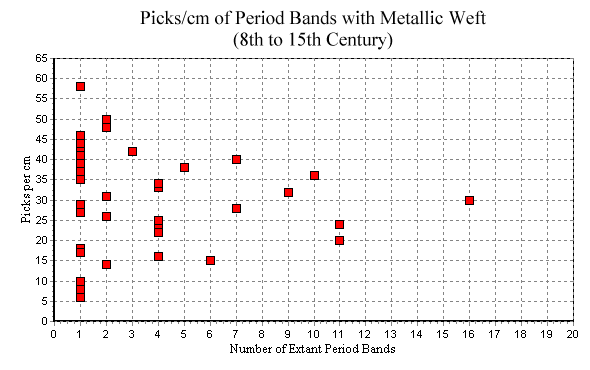

The following charts show the number of extant bands with a given number of picks/cm
for each century from the 9th to the 14th.
 |
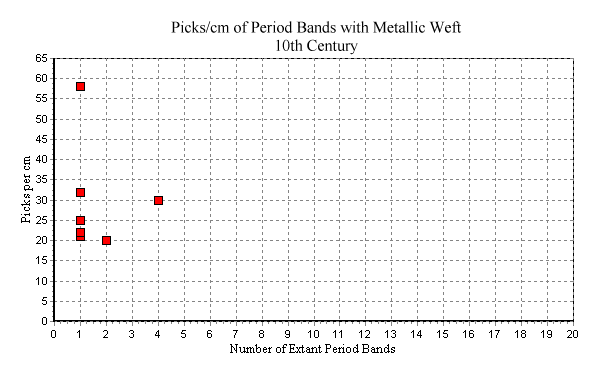 |
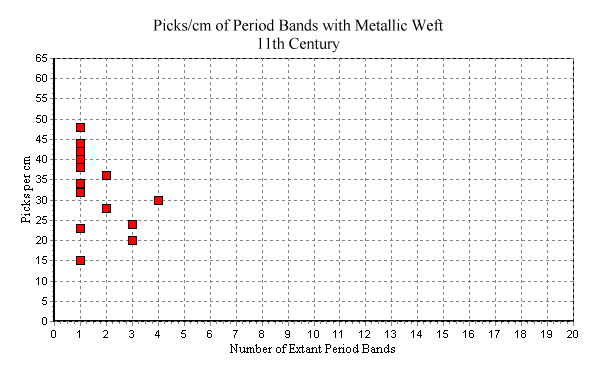 |
 |
 |
 |
13th century metallic thread Electron microscope photograph Source: Spies p61 |
Kreinik Japan #7 Metallic Thread Silver 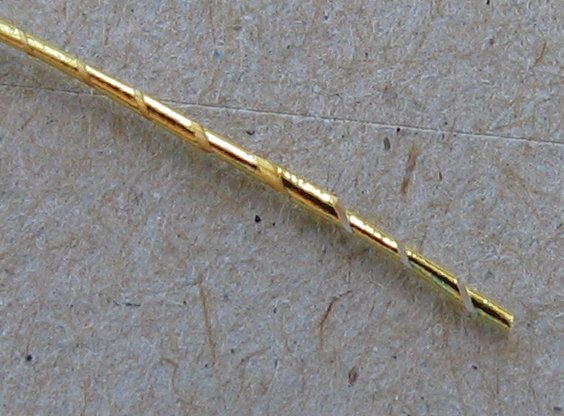 Gold |
Indian Real Metallic Thread Silver  Gold |
van Sciver Real Metallic Thread Silver 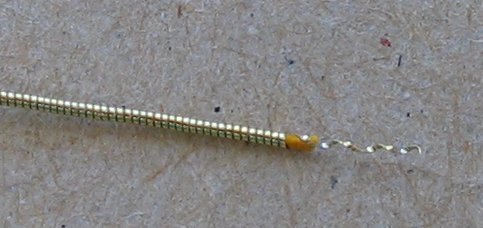 Gold |
Biddle, Martin. Object and Economy in Medieval Winchester. Oxford 1990.
Collingwood, Peter. The Techniques of Tabletweaving. London 1982.
Crowfoot, Elisabeth. 'Textiles' in Salisbury Museum Medieval Catalogue. Salisbury and South Wiltshire Museum, 1991.
Crowfoot, Elizabeth; Hawkes, Sonia Chadwick. 'Early Anglo-Saxon Gold Braids' in
Medieval Archaeology XI. 1967.
Crowfoot, Grace. 'The Tablet-woven Braids from the Vestments of St. Cuthbert at
Durham' in The Antiquaries Journal. (issue unknown)
Flury-Lemberg, Mechthild. Textilkonservierung im Namen der Forschung. Bern: Abegg Stiftung, 1988.
Geijer, Agnes. Birka III: Die Textilfunde aus den Gräbern. Uppsala 1938.
Gomez-Moreno, M. El Panteon Real de Las Huelgas de Burgos. Madrid 1946.
Kubach, Hans Erich; & Haas, Walter. Die Kunstdenkmäler von Rheinland-Pfalz:
Der Dom zu Speyer. Deutscher Kunstverlag, 1972.
Priest-Dorman, Carolyn. Scutulis Dividere Gallia: Weaving on Tablets in Western Europe. 1988.
Sorber, Frieda. Stof uit de Kist: De middeleeuwse textielschat uit de abdij
van Sint-Truiden. Sint-Truiden 1991.
Sorber, Frieda. 'The St.-Truiden Textiles: Embroidered Net, Tabletwoven Borders,
Braided and Knotted Trim' in Medieval Textiles, Particularly in the Meuse-Rhine
Area. Sint-Truiden 1991.
Spies, Nancy. Ecclesiastical Pomp and Aristocratic Circumstance: A Thousand
Years of Brocaded Tabletwoven Bands. Arelate Studio, Jarrettsville 2000.
'Zingulum des Bischofs Witgarius von Augsburg' in Suevia Sacra: Frühe Kunst in
Schwaben (Exhibition Catalog). Augsburg 1973.
(1) Spies p125/6.